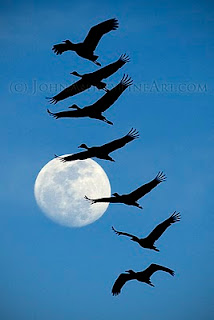Let's begin by reminding everyone to NEVER look directly at the sun through your camera! Even a medium lens is enough focal power to fry your retina. Only a dimwit would aim a fat telephoto lens at the blazing sun -- so let me tell you how I did it.
I came to this Arizona wetland last winter to photograph Sandhill Cranes. We spent two evenings running around the desert to line up a flock cranes with the rising moon. It was harder than I expected. This year, capturing cranes against the sun turned out to be easier than expected -- but I still had to scout for two days to find the best location.
 |
| Sandhill Cranes flying across the sun (c) John Ashley |
First, a 500mm lens attached to the D700, a cable release attached to the camera, and everything anchored to the tripod. Aiming slightly to the right of the sun, I prefocused on the expected flight path. (Hint -- it isn't infinity. That would be too easy.)
Now for the "trick." I set the D700 to "live view" and, watching the live image on the rear LCD screen, I can safely aim the camera directly into the sun. Now I just have to shield the sun with my left hand and, when the flock approaches the inferno, fire away with the remote release.
So I never actually see the birds cross the sun. And, if their path takes them across the center of the sun, then those few birds usually just dissappear from the image. Buts the sun's constantly moving, and the birds will fly higher and lower, nearer and farther away, so it's still a matter of luck and patience.
If it's early (or late) in the day, and there is a significant amount of thin clouds, fog, or whatever, then these will act like a neutral density filter and knock the sun back for you. Plus, you'll get a nice, sharp edge around the sun. But the sun is going to roast your image on a clear day. For days like this, the camera's ISO is set as low as it will go, while aperture and shutter speed are as high as they will go.
(Side notes: I almost always shoot wide open, so I seldom have problems with dusty sensors. Stopping the lens all the way down, however, was an ugly, ugly awakening. Also, stopping down past about f8 increases diffraction and decreases sharpness. In this sun example, however, soft focus can actually add to the images' "feel.")


No comments:
Post a Comment